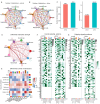Integrative analyses of bulk and single-cell transcriptomics reveals the infiltration and crosstalk of cancer-associated fibroblasts as a novel predictor for prognosis and microenvironment remodeling in intrahepatic cholangiocarcinoma
- PMID: 38702814
- PMCID: PMC11071156
- DOI: 10.1186/s12967-024-05238-z
Integrative analyses of bulk and single-cell transcriptomics reveals the infiltration and crosstalk of cancer-associated fibroblasts as a novel predictor for prognosis and microenvironment remodeling in intrahepatic cholangiocarcinoma
Abstract
Background: Intrahepatic cholangiocarcinoma (ICC) is a highly malignant neoplasm and characterized by desmoplastic matrix. The heterogeneity and crosstalk of tumor microenvironment remain incompletely understood.
Methods: To address this gap, we performed Weighted Gene Co-expression Network Analysis (WGCNA) to identify and construct a cancer associated fibroblasts (CAFs) infiltration biomarker. We also depicted the intercellular communication network and important receptor-ligand complexes using the single-cell transcriptomics analysis of tumor and Adjacent normal tissue.
Results: Through the intersection of TCGA DEGs and WGCNA module genes, 784 differential genes related to CAFs infiltration were obtained. After a series of regression analyses, the CAFs score was generated by integrating the expressions of EVA1A, APBA2, LRRTM4, GOLGA8M, BPIFB2, and their corresponding coefficients. In the TCGA-CHOL, GSE89748, and 107,943 cohorts, the high CAFs score group showed unfavorable survival prognosis (p < 0.001, p = 0.0074, p = 0.028, respectively). Additionally, a series of drugs have been predicted to be more sensitive to the high-risk group (p < 0.05). Subsequent to dimension reduction and clustering, thirteen clusters were identified to construct the single-cell atlas. Cell-cell interaction analysis unveiled significant enhancement of signal transduction in tumor tissues, particularly from fibroblasts to malignant cells via diverse pathways. Moreover, SCENIC analysis indicated that HOXA5, WT1, and LHX2 are fibroblast specific motifs.
Conclusions: This study reveals the key role of fibroblasts - oncocytes interaction in the remodeling of the immunosuppressive microenvironment in intrahepatic cholangiocarcinoma. Subsequently, it may trigger cascade activation of downstream signaling pathways such as PI3K-AKT and Notch in tumor, thus initiating tumorigenesis. Targeted drugs aimed at disrupting fibroblasts-tumor cell interaction, along with associated enrichment pathways, show potential in mitigating the immunosuppressive microenvironment that facilitates tumor progression.
Keywords: Cancer-associated fibroblasts; Intercellular communication; Intrahepatic cholangiocarcinoma; Prognosis; Single cell transcriptomic; WGCNA.
© 2024. The Author(s).
Conflict of interest statement
The authors declare that they have no competing interests.
Figures









References
-
- Ali PI, Saleem K, Aboul-Enein H, Rather M, Imran D. Social Aspects of Cancer Genesis.
Publication types
MeSH terms
Grants and funding
- ZYJC21046/1.3.5 project for disciplines of excellence, West China Hospital, Sichuan University
- 2021HXFH001/1.3.5 project for disciplines of excellence-Clinical Research Incubation Project, West China Hospital, Sichuan University
- 2022NSFSC0806/Natural Science Foundation of Sichuan Province
- 2021YJ0132/Sichuan Science and Technology Program
- 2021YFS0100/Sichuan Science and Technology Program
- 2021M692277/The fellowship of China Postdoctoral Science Foundation
- 2021CDZG-23/Sichuan University-Zigong School-local Cooperation project
- 21PJ046/Science and Technology project of the Health planning committee of Sichuan
- 2021HXBH127/Post-Doctor Research Project, West China Hospital, Sichuan University
LinkOut - more resources
Full Text Sources
Medical
Miscellaneous

